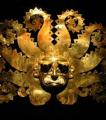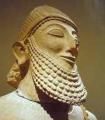- 19 SEPTEMBRE :
- U.S.A. : Philadelphia - Cleo-mania continues at the Franklin Institute as the fall approaches and the exclusive exhibit “Cleopatra: The Search for the Last Queen of Egypt” wows visitors. Organized by National Geographic and Arts and Exhibitions International, with cooperation from the Egyptian Supreme Council of Antiquities and the European Institute for Underwater Archaeology (IEASM), the Cleopatra exhibition features about 150 artifacts, and takes visitors inside the search for Cleopatra. The world exclusive premiere exhibit is at the Franklin through Jan. 2.
http://www.delcotimes.com/articles/2010/09/18/entertainment/doc4c92828050e03238539653.txt
- FRANCE : Paris - À la Pinacothèque de Paris, du 10 septembre 2010 au 6 février 2011, le public pourra admirer objets et bijoux en or et en argent, témoins de la civilisation inca. Une exposition exceptionnelle, placée sous haute surveillance. L'or est la sueur du Soleil, tandis que l'argent est associé à la Lune. C'est ainsi que les Incas, qui ont dominé les Andes de 1400 à 1533, percevaient ces métaux précieux. L'empereur inca était considéré comme l'incarnation humaine du Soleil, et l'or était symbole de pouvoir. D'où la place accordée au métal jaune dans la confection de divers objets de prestige : diadèmes, boucles d'oreilles, vaisselle rituelle, pectoraux, colliers... Autant d'objets - 253 pièces au total - que les visiteurs peuvent admirer.
Paris - À la Pinacothèque de Paris, du 10 septembre 2010 au 6 février 2011, le public pourra admirer objets et bijoux en or et en argent, témoins de la civilisation inca. Une exposition exceptionnelle, placée sous haute surveillance. L'or est la sueur du Soleil, tandis que l'argent est associé à la Lune. C'est ainsi que les Incas, qui ont dominé les Andes de 1400 à 1533, percevaient ces métaux précieux. L'empereur inca était considéré comme l'incarnation humaine du Soleil, et l'or était symbole de pouvoir. D'où la place accordée au métal jaune dans la confection de divers objets de prestige : diadèmes, boucles d'oreilles, vaisselle rituelle, pectoraux, colliers... Autant d'objets - 253 pièces au total - que les visiteurs peuvent admirer.
http://fr.news.yahoo.com/68/20100918/tsc-lor-des-incas-une-exposition-unique-04aaa9b.html
- 25 AOÛT :
- U.S.A. :  Fort Worth - Fiery Pool: The Maya and the Mythic Sea opens today at the Kimbell Art Museum. This exhibit is about the Maya's physical and spiritual relationship with water and covers a span of 2,000 years. from the first millennium B.C to the European invasion in the 1500s. About 20 years ago, the Maya glyph for water was deciphered by pre-Colombian scholars and almost immediately a whole new meaning was given to a slew of Maya artifacts. This new scholarship is what is on display at the Kimbell, items that heretofore might have been misunderstood or misattributed. There are more than 90 works in the exhibit, some recently excavated
Fort Worth - Fiery Pool: The Maya and the Mythic Sea opens today at the Kimbell Art Museum. This exhibit is about the Maya's physical and spiritual relationship with water and covers a span of 2,000 years. from the first millennium B.C to the European invasion in the 1500s. About 20 years ago, the Maya glyph for water was deciphered by pre-Colombian scholars and almost immediately a whole new meaning was given to a slew of Maya artifacts. This new scholarship is what is on display at the Kimbell, items that heretofore might have been misunderstood or misattributed. There are more than 90 works in the exhibit, some recently excavated
http://www.star-telegram.com/2010/08/25/2425243/ancient-mayans-thirsted-for-more.html
- 20 AOÛT :
MEXIQUE : Mexico City - L'exposition La huella en los huesos. Un acercamiento a la antropología física a récemment été inaugurée au Palacio de la Escuela de Medicina, à Mexico et sera visible gratuitement jusqu'à janvier 2011. L'anthropologique physique et la médecine légale ont pour la première fois depuis longtemps un espace qui leur est dédié. Cette discipline prend une part de plus en plus prépondérante dans les interprétations que les archéologues et les historiens peuvent faire, à partir des matériaux osseux retrouvés lors de fouilles. L'un des conservateurs de l'expo, Concepción Jiménez, explique sur le site de l'INAH qu'on a pu ainsi établir la présence de la syphilis bien avant l'arrivée des Espagnols, contrairement aux préjugés qu'on a sur le génocide des populations indigènes au moment de la Conquête. Au total, 150 pièces sont proposées au public, toutes présentant des traces de maladies sur des individus ayant vécu entre 14000 avant notre ère et le 20è siècle. L'exposition compte notamment deux des individus les plus anciens du continent américain : la Femme du Peñon au crâne déformé et l'Homme de Chimalhuacán.
Mexico City - L'exposition La huella en los huesos. Un acercamiento a la antropología física a récemment été inaugurée au Palacio de la Escuela de Medicina, à Mexico et sera visible gratuitement jusqu'à janvier 2011. L'anthropologique physique et la médecine légale ont pour la première fois depuis longtemps un espace qui leur est dédié. Cette discipline prend une part de plus en plus prépondérante dans les interprétations que les archéologues et les historiens peuvent faire, à partir des matériaux osseux retrouvés lors de fouilles. L'un des conservateurs de l'expo, Concepción Jiménez, explique sur le site de l'INAH qu'on a pu ainsi établir la présence de la syphilis bien avant l'arrivée des Espagnols, contrairement aux préjugés qu'on a sur le génocide des populations indigènes au moment de la Conquête. Au total, 150 pièces sont proposées au public, toutes présentant des traces de maladies sur des individus ayant vécu entre 14000 avant notre ère et le 20è siècle. L'exposition compte notamment deux des individus les plus anciens du continent américain : la Femme du Peñon au crâne déformé et l'Homme de Chimalhuacán.
L'idée étant de faire comprendre l'anthropologie physique au plus grand nombre, un laboratoire d'analyse et un chantier de fouilles archéologiques ont été reconstitués. Le visiteur aura un panorama complet et précis de cette discipline peu connue du grand public mais incontournable pour l'archéologie moderne.
http://mexiqueancien.blogspot.com/2010/08/exposition-la-huella-en-los-huesos.html
- 18 AOÛT :
PEROU :  Lima - The Museo Nacional de Arqueología, Antropología e Historia opens a new exhibit about Peru's vast rainforest called Amazonía. The exhibit has approximately 70 pieces belonging to groups including the Tutishcainyo, Chambira, Shakimu, Cumancaya, Kuélap, Gran Pajatén, Shipibo-Conibo, Aguaruna, Cacataibo, Machinguenga, and the Chachapoyas cultures. Archaeological objects such as vases, utensils, clothes, hunting weapons illustrate these cultures' history in Peru.
Lima - The Museo Nacional de Arqueología, Antropología e Historia opens a new exhibit about Peru's vast rainforest called Amazonía. The exhibit has approximately 70 pieces belonging to groups including the Tutishcainyo, Chambira, Shakimu, Cumancaya, Kuélap, Gran Pajatén, Shipibo-Conibo, Aguaruna, Cacataibo, Machinguenga, and the Chachapoyas cultures. Archaeological objects such as vases, utensils, clothes, hunting weapons illustrate these cultures' history in Peru.
http://www.livinginperu.com/blogs/features/1605
GRECE :  An exhibition entitled "The Mechanism of Antikythera" will be on display on the southwestern Aegean island of Kythera (Kythira) until Sept. 19. The exhibition opened on Aug. 11 in Potamos, Kythera while on Aug. 19 the exhibition will be transferred to Chora, the island's main town. Visitors of the exhibition will be able to learn about the history of the ancient mechanism, believed to be an ancient mechanical calculator (also described as a primordial "mechanical computer") designed to calculate astronomical positions. The artifact was discovered within an ancient shipwreck off the nearby isle of Antikythera, between Kythera and Crete . It has been dated to about 150-100 BC. Technological devises of similar complexity appeared a thousand years later, scholars have noted.
An exhibition entitled "The Mechanism of Antikythera" will be on display on the southwestern Aegean island of Kythera (Kythira) until Sept. 19. The exhibition opened on Aug. 11 in Potamos, Kythera while on Aug. 19 the exhibition will be transferred to Chora, the island's main town. Visitors of the exhibition will be able to learn about the history of the ancient mechanism, believed to be an ancient mechanical calculator (also described as a primordial "mechanical computer") designed to calculate astronomical positions. The artifact was discovered within an ancient shipwreck off the nearby isle of Antikythera, between Kythera and Crete . It has been dated to about 150-100 BC. Technological devises of similar complexity appeared a thousand years later, scholars have noted.
http://www.ana-mpa.gr/anaweb/user/showplain?maindoc=9011101&maindocimg=4285621&service=144
- 17 AOÛT :
MEXIQUE :  Mexico City - The goods found in graves of six leaders of the classic period of Maya culture (AD 200-900), which had been distributed to various museums after the exploration of their graves, now recover their original meaning in an exhibition that opened Thursday in the Mexican capital. A total of 147 parts originating in southern Mexico make up the exhibition "Faces of divinity. The Mayan jade mosaic," the first exhibition that offers a complete reading of "the historic and symbolic values that characterize these offerings," said curator Sofia Martinez del Campo. The capital's National Museum of Anthropology and History commemorates the ceremonies "with deep ritual symbolism" honored Maya rulers as if they were divine beings, "said the expert. These goods were for King Pakal, whose tomb has always been considered one of the most important archaeological finds in Mexico, and six other dignitaries whose names are not known. The goods come mostly from archaeological sites in Palenque (Chiapas), Calakmul (Campeche), Dzibanché (Quintana Roo) and Oxkintok (Yucatan).
Mexico City - The goods found in graves of six leaders of the classic period of Maya culture (AD 200-900), which had been distributed to various museums after the exploration of their graves, now recover their original meaning in an exhibition that opened Thursday in the Mexican capital. A total of 147 parts originating in southern Mexico make up the exhibition "Faces of divinity. The Mayan jade mosaic," the first exhibition that offers a complete reading of "the historic and symbolic values that characterize these offerings," said curator Sofia Martinez del Campo. The capital's National Museum of Anthropology and History commemorates the ceremonies "with deep ritual symbolism" honored Maya rulers as if they were divine beings, "said the expert. These goods were for King Pakal, whose tomb has always been considered one of the most important archaeological finds in Mexico, and six other dignitaries whose names are not known. The goods come mostly from archaeological sites in Palenque (Chiapas), Calakmul (Campeche), Dzibanché (Quintana Roo) and Oxkintok (Yucatan).
http://www.artdaily.com/index.asp?int_new=39979&int_sec=2
- 08 AOÛT :
U.S.A. :  Washington - THE SMITHSONIAN’S Museum of Natural History in Washington is to exhibit a large collection of Cypriot artifacts to mark the 50th anniversary of the Cyprus Republic titled ‘Cyprus: Crossroads of Civilisations’. The exhibition will be on view from September 29 until May 1 next year and it will feature about 260 items, many of which are being displayed for the first time in the US. They cover nearly 11,000 years of history, from the Cypriot-Archaic period through to the Venetian period, and include artifacts from the earliest villages to the masterpieces of medieval religious art.
Washington - THE SMITHSONIAN’S Museum of Natural History in Washington is to exhibit a large collection of Cypriot artifacts to mark the 50th anniversary of the Cyprus Republic titled ‘Cyprus: Crossroads of Civilisations’. The exhibition will be on view from September 29 until May 1 next year and it will feature about 260 items, many of which are being displayed for the first time in the US. They cover nearly 11,000 years of history, from the Cypriot-Archaic period through to the Venetian period, and include artifacts from the earliest villages to the masterpieces of medieval religious art.
http://www.cyprus-mail.com/cyprus/cyprus-smithsonian/20100807